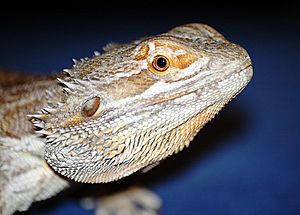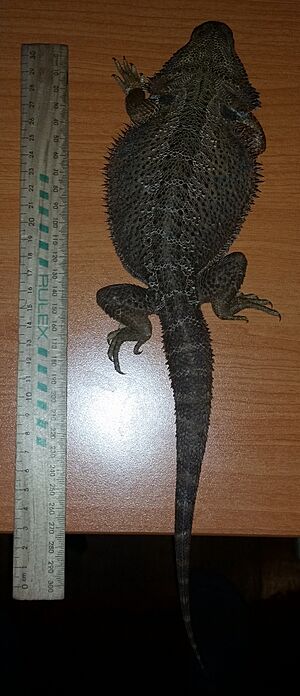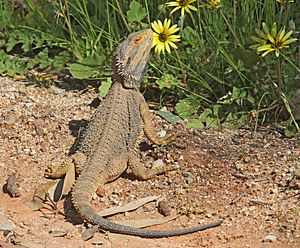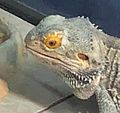Bearded dragons facts for kids
Quick facts for kids Bearded dragons |
|
|---|---|
 |
|
| Pogona vitticeps | |
 |
|
| P. vitticeps – detail of head | |
| Scientific classification |
|
| Kingdom: | Animalia |
| Phylum: | Chordata |
| Class: | Reptilia |
| Order: | Squamata |
| Suborder: | Iguania |
| Family: | Agamidae |
| Subfamily: | Amphibolurinae |
| Genus: | Pogona Storr, 1982 |
| Species | |
|
|
Pogona is a group of eight different lizard species. They are commonly known as bearded dragons. Their name comes from the spiky skin under their throat, which looks like a beard. This "beard" can turn black and puff up. They do this when they feel scared, stressed, or want to attract a mate.
Bearded dragons live in places like deserts and shrublands in Australia. They spend a lot of time on branches, in bushes, and even near people's homes. They like to warm up in the sun on rocks and branches in the morning and afternoon. They sleep at night, which means they are active during the day (this is called diurnal). They mostly eat plants, but they also enjoy some insects.

Bearded dragons have wide, triangle-shaped heads and flat bodies. Their bodies are covered in rows of spiky scales. When they feel threatened, they puff up their bodies and beards. This makes their spikes look more dangerous to scare away predators.
Bearded dragons also use special movements to talk to each other. They do a "hand-waving" gesture to show they are being friendly or giving up. This often happens when they enter another dragon's territory. They also do a "head-bobbing" display to show they are in charge. Some bearded dragons can even change color a little bit. They might turn black to soak up more heat from the sun. They come in many different colors and patterns. Male bearded dragons can grow up to 60 cm (24 in) long, and females up to 51 cm (20 in).
These lizards come from dry areas in Australia. They live in arid and subtropical woodlands, scrublands, and savannas. They are good climbers and often climb high to warm themselves in the sun. This climbing can also show which dragon is in charge. You can find them on fallen trees, rocks, and bushes.
Bearded dragons go through a special kind of "sleep" called brumation. It's like hibernation, but they might wake up to drink water. They become less active when it gets too cold. If the temperature drops below 15.5–21.0°C (60–70°F) at night, or stays below 24.0–26.5°C (75–80°F) during the day, they will brumate. When it's too hot, they dig underground to stay cool. They also make burrows to protect themselves from changing weather and other animals.
Contents
Behavior
Adult bearded dragons like to have their own space. As they grow, they create territories. They use aggressive and friendly actions to interact with other dragons. A male dragon that is in charge will stand tall. He might get ready to fight another male to protect his territory or food. He also fights for a female. Any male who comes close without showing he's friendly is seen as a challenge. Strong males have even attacked females who didn't show friendly signs back.
Male bearded dragons have stronger bites than females. This is because their heads are bigger.
The beard is used for mating and showing aggression. It also helps them control their body heat. Both male and female dragons have a beard. Males use their beards more often, especially when trying to find a mate. Females also use their beards to show they are angry. The beard gets darker, sometimes turning black, and puffs up during these displays. A bearded dragon might also open its mouth wide to look even more scary. If a predator threatens them, they might hiss, puff up their bodies, and lean towards the danger. Bearded dragons have strong jaws, but they usually only bite as a last choice.
Head bobbing is another behavior seen in both males and females. They quickly move their heads up and down, often darkening their beards. Different speeds of head bobbing might mean different things. Males bob their heads to impress females. A male often has to show he is dominant before a female will agree to mate. Smaller males often wave their arms when a larger male bobs his head. This is a sign of giving up. Females also wave their arms to avoid fights, especially when a male bobs his head. Female bearded dragons have been seen lowering themselves to the ground and waving their arms. They do this while moving away from a dominant male to calm him down or escape.
Bearded dragons can even see optical illusions! In one experiment, they were shown two different-sized plates with the same amount of food. The dragons chose the smaller plate more often. This showed they understood that a bigger plate doesn't always mean more food. This was the first time this behavior was seen in a reptile.
Reproduction
After their winter sleep (brumation) ends, male bearded dragons look for a mate. The male performs a special dance. He bobs his head, waves his arms, and stomps his feet in front of the female.
Females can lay a group of 11–30 eggs. They can do this twice from just one mating.
The temperature during egg development can decide if a baby dragon becomes male or female. If the eggs are incubated at higher temperatures (above 31 °C (88 °F)), male embryos can turn into females. These dragons will look like females but still have male genes. Higher temperatures, up to 36°C, increase the chance of this happening. Temperatures below 31°C will not cause this change. Interestingly, these "sex-reversed" females are very similar to regular females. One study found that male dragons have a stronger bite than both regular females and sex-reversed females.
Like many other reptiles, female bearded dragons can lay eggs even without a male. These eggs are usually smaller and softer. If you break them open, they will have a yellow yolk.
Congenital defects
Sometimes, baby bearded dragons are born with problems. These are called birth defects. They can be caused by problems with genes, chemicals, or other things in their environment.
- Bicephalism means a bearded dragon is born with two heads but one body.
- Anasarca is when a bearded dragon is swollen inside the egg. The egg might look like it's sweating. We don't know why this happens.
- Shistosomus reflexa is when a bearded dragon's organs grow outside its body.
- Spinal and limb defects are problems with the spine, tail, legs, or toes. This can happen if the mother didn't get enough nutrients, or if there was an injury or temperature problem during development.
- Micropthalmia/anopthalmia means a bearded dragon is born with very small eyes or no eyes at all. This is usually caused by something bad happening during eye development.
- Hermaphroditism is when a bearded dragon has both male and female reproductive parts. Dragons born this way cannot have babies.
In captivity
The central bearded dragon is the most common type kept as a pet. They are one of the most popular pet reptiles! Smaller types, like Pogona henrylawsoni, are also kept as pets if there isn't much space. Bearded dragons became popular pets in the U.S. in the 1990s. Their popularity has continued, even though Australia stopped selling its wildlife as pets in the 1960s.
Bearded dragons are usually solitary animals. Males are often kept alone because they might fight with other males. Adult pet dragons grow to about 40 to 61 cm (16 to 24 in) long from head to tail. They weigh 290 to 600 g (10 to 20 oz). With good care, they can live for about 10 to 15 years. The longest a bearded dragon has lived in captivity is 18 years!
People have bred central bearded dragons to create many different "morphs," which are versions with unique colors and patterns. Some common traits include "hypomelanism," which means lighter, brighter colors. "Translucent" dragons have skin that is less see-through, making their colors look stronger, and they have black eyes. "Leatherbacks" have smoother skin because they have fewer scales. "Silkbacks" have very soft skin. "German giants" are larger than average. Silkbacks need extra special care because their skin is very delicate. They need different UV light and humidity levels. They also tend to live shorter lives.
Common health issues
Bearded dragons are usually strong, but they can get sick if they are not cared for properly. Some common health problems include metabolic bone disease, adenovirus, impaction, and parasites. Most health issues in pet bearded dragons happen because of a poor diet or not enough heat and light.
Metabolic bone disease
Metabolic bone disease (MBD) is a serious illness that can be deadly. It's one of the most common health problems for bearded dragons. MBD makes their bones weak and can cause them to become deformed. It happens when dragons don't get enough calcium or the right lighting. They need special UVB light to use the calcium from their food. Without enough calcium, their bodies take calcium from their bones, making them weak.
Pet bearded dragons need calcium supplements. They also need a UVB light every day. Foods like kale, mustard greens, and collard greens are high in calcium. These should be part of their daily diet along with other leafy greens and vegetables. Signs of MBD include bumps on their legs, twitches, bumps on their spine or tail, a swollen jaw, and jerky movements.
Hypocalcemia
Hypocalcemia means there are low levels of calcium in the dragon's blood. This is often linked to metabolic bone disease. Low calcium can cause muscle twitching or even seizures. Young bearded dragons are more likely to get hypocalcemia because they are more delicate. Giving your dragon enough calcium in its diet is very important to prevent both hypocalcemia and MBD.
Impaction
Impaction often happens when bearded dragons eat food that is too big for them. They might try to eat worms or crickets that are too large. This can be very harmful. For young dragons, food should be no bigger than the space between their eyes. Older dragons can usually handle bigger insects, but not giant ones. If a dragon eats food that is too big, it can put pressure on its spinal cord during digestion. This pressure can lead to impaction, which can be deadly. Another cause of impaction is eating their bedding, like sand.
Upper Respiratory Infection (URI)
A respiratory infection (RI) in bearded dragons is caused by bacteria in their lungs. Dragons can get a respiratory infection for many reasons. These include wrong lighting, wrong temperature, too much humidity, long-term stress, or bad living conditions.
Atadenovirus
Atadenovirus (ADV), also called adenovirus, is a dangerous viral disease. It can spread between reptiles just by contact. Most young dragons with ADV do not live past 90 days. Adult dragons with ADV live longer, but they often get liver diseases later on. Common signs of ADV are slow growth and not gaining enough weight. Because their immune systems are weak, dragons with ADV might also get other infections, like intestinal parasites.
Lighting
Bearded dragons need UVB light. This light helps their bodies make vitamin D3. Vitamin D3 is very important for absorbing calcium. Calcium helps with many important body functions. Bearded dragons also need UVA light. UVA light helps them eat, breed, warm up in the sun, and stay healthy overall. They also need a warm spot to bask, usually from a heat lamp. Both heat and UV light are vital for a bearded dragon's body to work properly.
Species
There are six recognized species of Pogona:
- Pogona barbata – Eastern bearded dragon
- Pogona henrylawsoni – Rankin's dragon, Lawson's dragon, black-soil bearded dragon, dumpy dragon, dwarf bearded dragon
- Pogona microlepidota – Kimberley bearded dragon, Drysdale river bearded dragon
- Pogona minor – Western bearded dragon, dwarf bearded dragon
- Pogona nullarbor – Nullarbor bearded dragon
- Pogona vitticeps – Central bearded dragon or inland bearded dragon
Gallery
See also
 In Spanish: Pogona para niños
In Spanish: Pogona para niños









